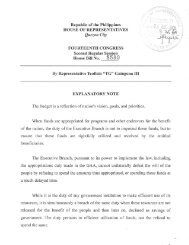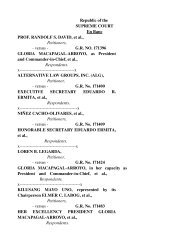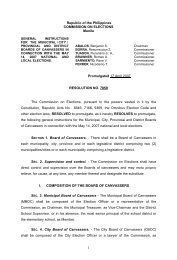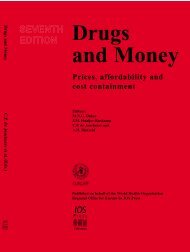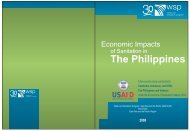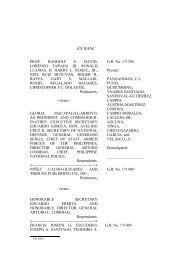i Report Issue No. 3 2005 - Philippine Center for Investigative ...
i Report Issue No. 3 2005 - Philippine Center for Investigative ...
i Report Issue No. 3 2005 - Philippine Center for Investigative ...
You also want an ePaper? Increase the reach of your titles
YUMPU automatically turns print PDFs into web optimized ePapers that Google loves.
FOCUS ON FILIPINO YOUTH<br />
real impact, especially among<br />
more impressionable youth. A<br />
2003 study by advertising giant<br />
McCann-Erickson found that media<br />
have become “surrogate parents”<br />
to the country’s youth. The<br />
media act as arbitrators of right<br />
and wrong, hip and cool, what’s<br />
in and what’s as passe as last<br />
year’s ponchos. TV viewership<br />
especially rates high among the<br />
youth who spend about eight to<br />
14 hours a week watching TV.<br />
CHERYL CHAN<br />
THE QUEUES<br />
in mall bathrooms<br />
attest to our national vanity.<br />
With all the women putting on<br />
lipstick, powdering their noses,<br />
and whipping their dangerously<br />
long, buhaghag-free hair be-<br />
tween vigorous brushstrokes, it<br />
is nearly impossible to get to the<br />
sink to wash hands. Whether the<br />
vanity is cause or effect, I’m not<br />
sure. Probably a little of both.<br />
Cutting una bella figura, as<br />
the Italians say, is important in<br />
the <strong>Philippine</strong>s. Filipinas pride<br />
themselves on their looks and<br />
deservedly so. Filipinos are a<br />
beautiful people, a product of a<br />
beautiful heritage. Even the men<br />
haven’t been spared the urge to<br />
look good, and in recent years<br />
they have become increasingly<br />
willing to splurge on beauty<br />
products. But the majority of<br />
buyers is still female—and, it<br />
seems, getting younger. A quick<br />
browse in “Primp and Prettify”<br />
<strong>for</strong>um on GirlTalk, a popular<br />
message board dedicated to<br />
young women easily turned up<br />
threads on facial and underarm<br />
whitening, rebonding, dieting<br />
pills, and make-up brands. I can<br />
empathize. Being vain can be an<br />
empowering experience. As in: I<br />
am woman. I exfoliate.<br />
In the <strong>Philippine</strong>s, manufacturers<br />
and advertisers are eager<br />
Business<br />
of Beauty<br />
to tap into the youth market,<br />
especially when it comes to<br />
personal care products. After<br />
all, the youth market is huge. In<br />
2001, about 57 percent of the<br />
population was under 25; 15-24<br />
year olds made up almost 20<br />
percent. Also, “me” products<br />
such as cosmetics, haircare,<br />
and beauty products do better<br />
with youth who are increasingly<br />
savvy, product-aware, and more<br />
willing to pamper themselves.<br />
And they also have more disposable<br />
income than older demographics.<br />
Plus, their being Pinoy<br />
means they will spend more time<br />
on their looks than most other<br />
people on the planet.<br />
If much of that marketing<br />
is still geared toward young<br />
females, well, girls have always<br />
been assumed to be conscious<br />
about their physical appearance.<br />
But these days it seems even<br />
those who are not yet quite in<br />
their teens are already worrying<br />
about how they look. Recently,<br />
our family was enjoying a<br />
birthday feast in honor of my<br />
grandfather when we noticed my<br />
12-year-old cousin just picking at<br />
her plate. It turned out she had<br />
put herself on a diet. I remember<br />
when my girlfriends and I were<br />
the same age and we thought<br />
nothing about stuffing our faces<br />
The<br />
with French fries and chocolates.<br />
Back then, only moms and much<br />
older sisters struggled with diets<br />
and exercise regimens.<br />
That wasn’t so long ago,<br />
yet things seem to have really<br />
changed since. Today the pressure<br />
to look good starts years<br />
be<strong>for</strong>e girls even hit puberty.<br />
The other day, my friend’s<br />
niece wistfully said she wished<br />
she were more maputi (fair-<br />
skinned). She is only six years<br />
old. Perhaps she aspires to be<br />
Snow White and she wants her<br />
very own set of seven dwarfs.<br />
Or she may have just walked<br />
away from the television set in<br />
which ads were extolling the<br />
virtues of fair skin and the other<br />
supposed standards of beauty.<br />
It seems we believe beauty<br />
is an ideal—especially when<br />
we leaf through glossy fashion<br />
magazines and see photos of<br />
gorgeous models. Or turn on<br />
the TV and wait eagerly <strong>for</strong> that<br />
magical moment when the kam-<br />
panerang kuba (hunchbacked<br />
bell ringer) is trans<strong>for</strong>med into<br />
a beautiful mestiza. Incidentally,<br />
that’s a teleserye that has kids<br />
among its target audience.<br />
Billboards, radio jingles, television<br />
commercials, magazine<br />
flyers, newspaper ads, and press<br />
releases—media exposure has<br />
NOW MAYBE it’s easy to make<br />
a six-year-old believe she has<br />
to be maputi to be considered<br />
pretty, but have that kid grow<br />
up a bit and she may not exactly<br />
be snapping up just any beauty<br />
product that promises to make<br />
her fair-skinned. Teens are a<br />
fickle market with no brand<br />
loyalty, says Art Ilano, assistant<br />
marketing professor at the<br />
University of the <strong>Philippine</strong>s in<br />
Diliman. They switch products<br />
easier, unlike older markets that<br />
tend to settle <strong>for</strong> certain brands.<br />
Because of this, companies have<br />
no choice but to bombard the<br />
youth market with constant reminders<br />
to “Buy me! Buy me!”<br />
And boy, do they bombard.<br />
According to market research<br />
company AC Neilsen, the personal-care<br />
industry poured P23.4<br />
billion in advertisements in 2004,<br />
a quarter higher than in 2003. In<br />
comparison, telecommunications<br />
is a distant second at P13 billion,<br />
and we already know how ubiquitous<br />
mobile-phone ads are.<br />
At P6 billion a year, skincare<br />
is second to haircare in<br />
ad expenditures, which stand<br />
at P10 billion (oral care is third<br />
at P3 billion). These numbers<br />
probably come as no surprise<br />
to people who drive down<br />
EDSA or read newspapers and<br />
magazines, and especially not<br />
to those who watch television,<br />
the most popular ad outlet.<br />
But it’s the skincare ad category<br />
that has seen the highest<br />
rate of growth. This is largely<br />
attributed to the increasing popularity<br />
of whitening products.<br />
According to a 2004 Synovate<br />
survey, skin-lightening products<br />
are popular across Asia. Some<br />
38 percent of women surveyed<br />
in Hong Kong, Malaysia, Korea,<br />
Taiwan, and the <strong>Philippine</strong>s use<br />
skin-lightening products.<br />
Filipinas, however, are the<br />
most avid consumers with 50<br />
percent of respondents reporting<br />
current use. My neighborhood<br />
46 PHILIPPINE CENTER FOR INVESTIGATIVE JOURNALISM I REPORT



